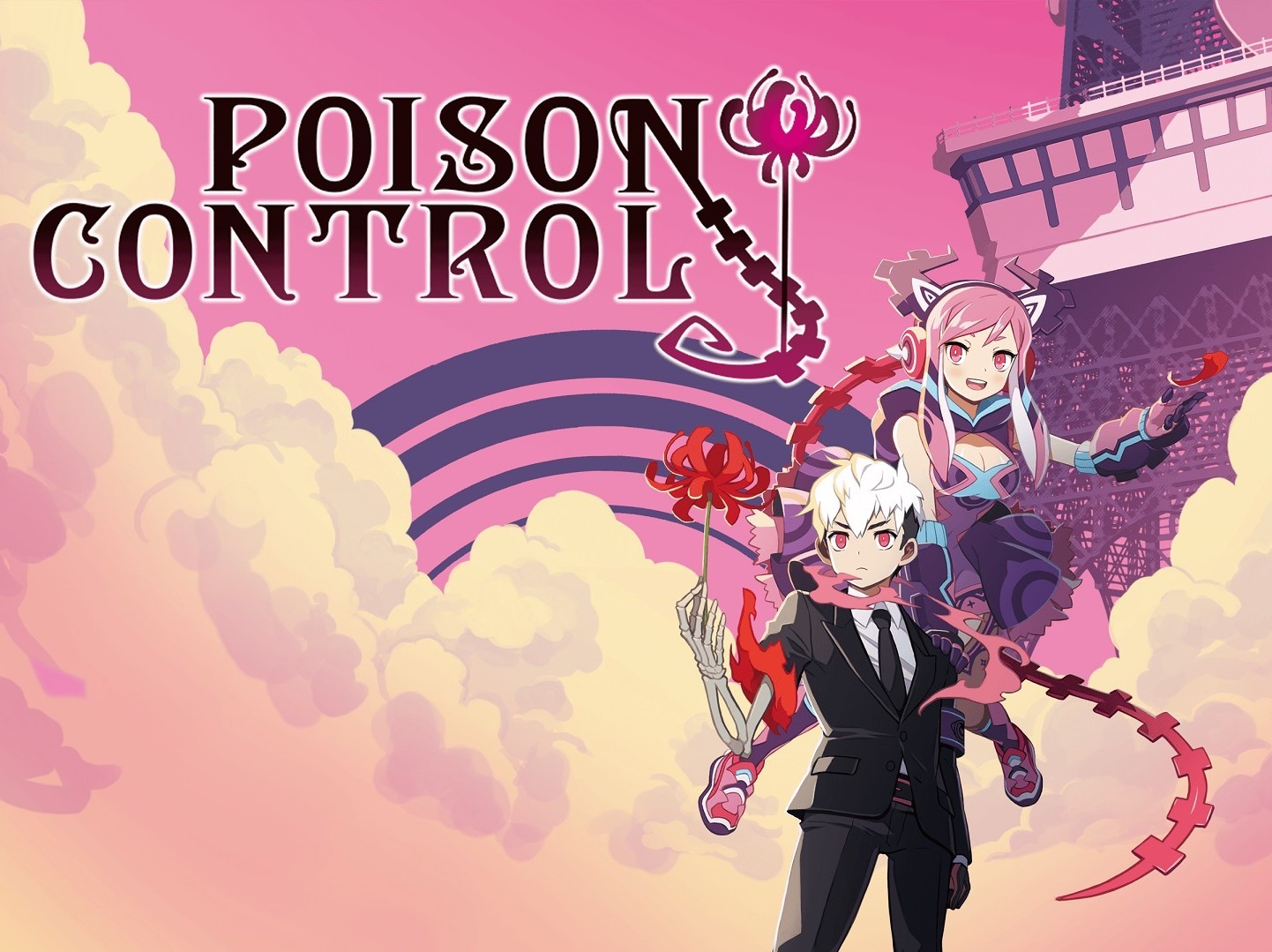Poison Control is a little hard to pigeonhole at first – it’s a mix of third-person shooter and a sort of anime picture-reveal poison-cleansing game. That type of thing is usually the realm of lewd internet-only games, but here they’ve dropped the lewd pictures underneath (for the most part) and instead added a loopy anime plot complete with body-sharing, skeletons, collecting stickers and exploring the seven circles of Hell. Sounds odd, right? Well, it is a bit.
Join me as we follow Poisonette into an inferno of pink eyeball-melting anime insanity that Dante could not have even dreamed of.

Poison Control just starts. There’s no intro movie or helpful explanations. A female monster approaches a first-person screen and bites you, then suddenly a pink-haired anime girl pops up out of nowhere claiming to have stolen your body. This is Poisonette, and she’s your new buddy whether you want her to be or not. Mostly concerned with her new rack, she absently gives you a little exposition; turns out you are a skeleton without her, the pink world you’ve ended up in is Hell, the monster that bit you was a Klesha and Poisonette at the same time, and you now share a body with her. And you have no choice in the matter.
You are ‘Soul-Mates’ – two beings in the same body. But it’s cool because sharing a body is like shape-shifting, especially for your new bodymate. Poisonette manifests as an arm cannon allowing you to shoot bullets at the enemy Klesha creatures. While she does this, most of her mass is in the arm cannon, so she becomes a little Chibi-version of herself that floats by your shoulder. She can also jump clean out of the shared body into her normal size (leaving you a pile of bones) to clear the poison mire – basically pink goo that covers the ground. Poison mires are the negative emotions of the Belles – fallen women whose personal Belle’s Hell need to be purified by you and Poisonette.
Each Hell is the manifestation of that particular Belle’s emotional turmoil or negative issues, and purging a Hell for a Belle changes their heart, and in many cases can send them back to the land of the living. Where have I heard this mechanic before? Yeah, it’s Persona 5 all over (if you need a reminder check out our review). Each Hell is literally an unimaginative square-maze version of a Persona palace, complete with props and enemy types that correspond to their backstory. You explore, find out more about the Belle in question and their negative personality, and then find at the end a Treasure, sorry a Soul Shard, which is an item that manifests the emotions in physical form. Yeah, straight outta Persona 5.
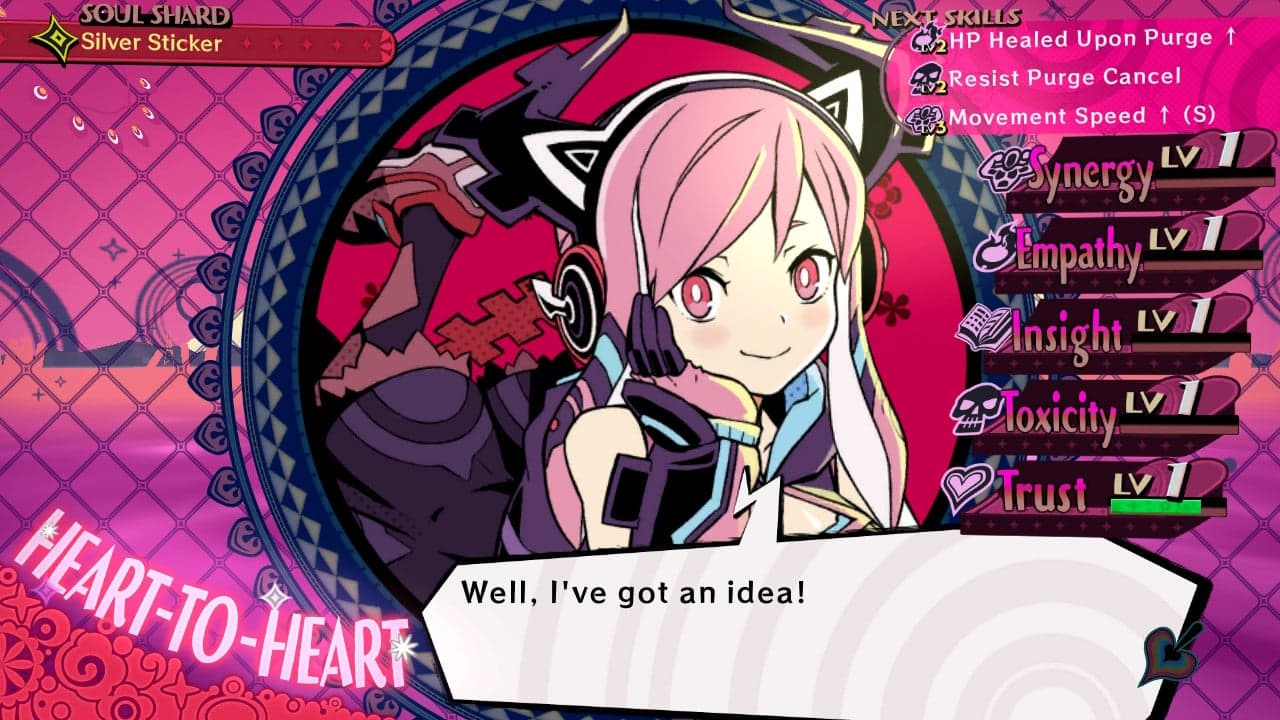
Complete a Hell and you get…a sticker. Five stickers means a ticket to Heaven for you and Poisonette and a chance at getting your own bodies back. The framework feels a lot like The World Ends With You, being in the afterworld, competing to find pins/stickers with which you get a second chance at life. I probably wouldn’t have made this connection were it not for the aesthetics on show which have a lot of similarities to that DS classic.
Beyond this there’s not a whole lot to the plot, but it does enough to keep you moving onward. Each Hell level has its own bitesize self-contained story and there’s a lot of tit for tat with rival Poisonettes and their respective body doubles, all vying for stickers to get to heaven in order to commandeer the body they share. You slowly reveal more about our own Poisonette, her strange amnesia and what led both you and her to be here in the first place.
Each level is introduced by two DJs who dominate Hell’s airwaves at Higan Radio. Midori and Kikiri generally liven up the whole thing and their script can be funny in places, but on the whole everyone is entirely too preoccupied with breasts. The game is a lot of noisy high-pitched excitable anime girls, so if that’s your thing you’ll be right at home, but if that’s the part of anime that really gets on your nerves, this is full of it. There’s no English dub. You have been warned.
It should be raised that there is one level which, following a light-hearted but distinctly horny level about a girl who drew suggestive manga for her classmates, is about a girl who moved from job to job after being sexually assaulted by a succession of bosses. Instead of catharsis coming from her being believed and helped, the entire thing is turned on its head and she is accused and bullied for being a liar, even by the protagonists, and then dies – supposedly for nothing. The fact that she’s treated as a liar and ridiculed is problematic at best, dangerously skewed at worst. That is not the message that was coming from the rest of the mildly interesting and morally grey vignettes, and it coloured my opinion of the game going forward.
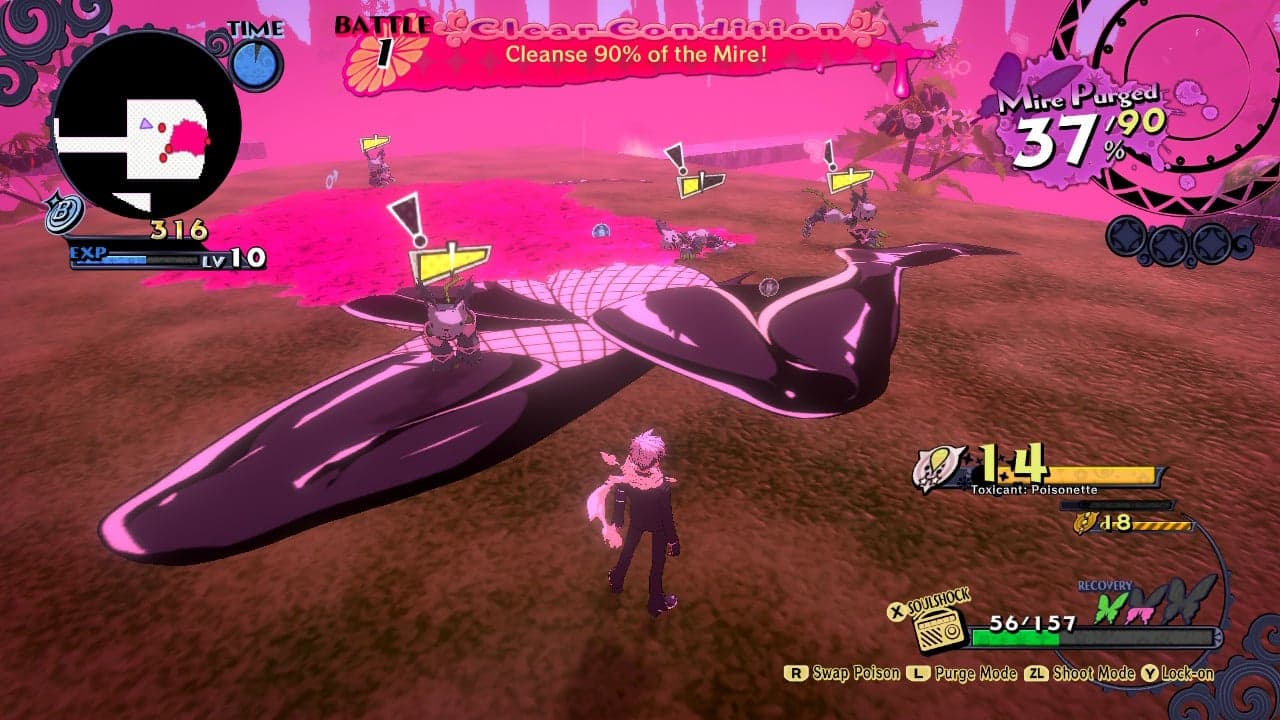
Considering the first Hell only lasts 20 minutes, five of them and their five stickers doesn’t seem like much of a game. Of course when you do attain the five stickers, the game throws a curveball at you and opens up to at least five times that size; there are many circles of hell, and you’re going to need to explore them all. Think of it like descending through Mementos in Persona 5, changing hearts and freeing Belles from Hells as you go.
Gameplay in Poison Control comes in two varieties; Shooting and Poison-clearing. Enemies dash about in the muck and need to be shot otherwise they will attack and generally hamper your attempts to clear the poison. If you’re smart, enemies can be stunned by drawing circles around them Okami-style through the mire. They’ll drop to the ground and can be dodged easily.
But you don’t want to avoid killing them even though it’s easy to do so. You need to take out Klesha to gain levels, and get strong enough to take out the bosses. Weapons have very small magazines and take an age to reload – you get reloads from clearing the muck, but only if you hit on pins/stickers that pop up and you collect.
The actual shooting mechanic is also very imprecise and you can easily pour bullets into enemies with nothing registering. Enemy AI ignores you at least half the time, which makes it feel like shooting fish in a barrel most of the game. The third-person element works, but there’s no flair to it, there’s not much fun to be had shooting. If the shooting in your game isn’t even fun to do, why is it in there?
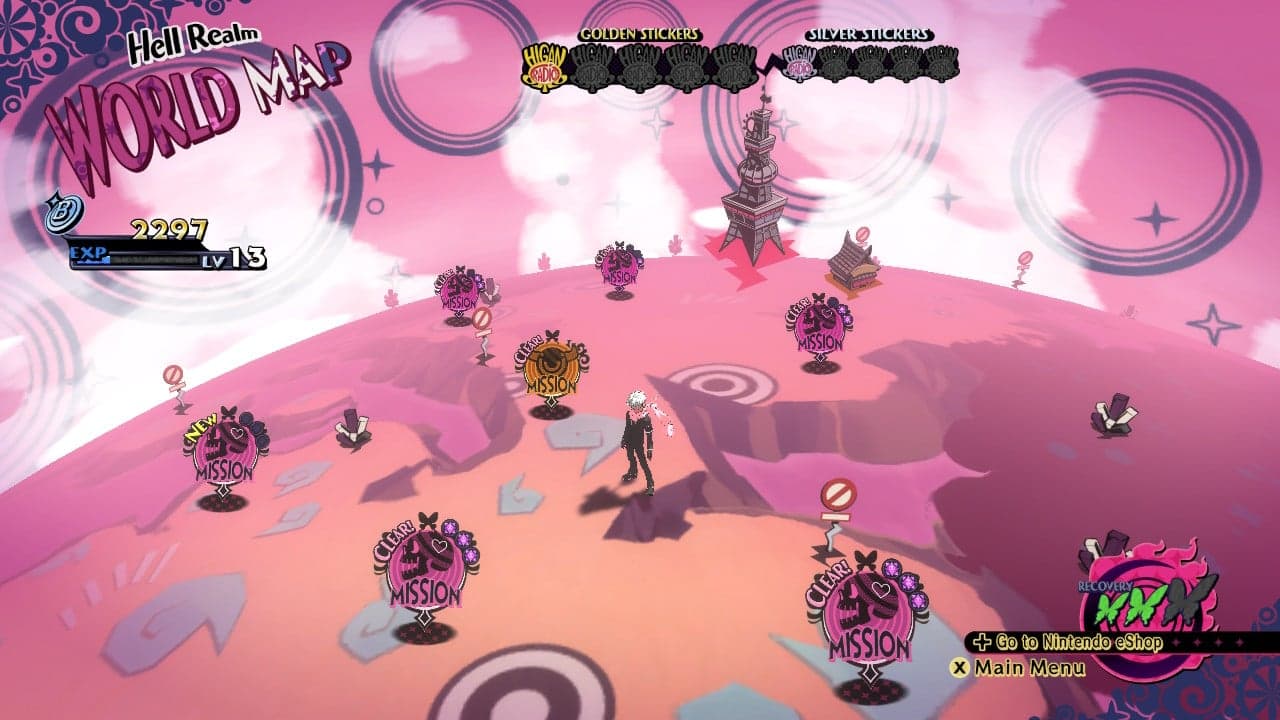
When you’re not shooting you are clearing pink goo by having Poisonette run over it. Usually there’s nothing underneath, but in some cases there can be pictures, and even in later levels, scantily clad lady pictures. Anime girls in various sexy poses with their panties on display. It never tips over into softcore or worse territory, but even so, it suddenly becomes that-kind-of-game.
Mostly by clearing poison you progress each area, or uncover a treasure chest. Gathering the poison gems knocking about the levels can give you more weapons and later on antidotes and catalysts. The only trouble is none of these really changes the gameplay, and can be largely ignored in favour of your original weapon once upgraded.
Poison Control develops into something a little unexpected; a simplified on-rails RPG. You gain EXP from kills, you level up a single stat bar as you progress, and you have control over five attributes that can increase based on dialogue responses when having an internal monologue with Poisonette (inside your shared body?).
The gameplay loop of shooting the same bad guys, clearing muck and leveling-up is alright, but it gets pretty boring pretty quickly. Ten levels will probably begin to stretch your interest levels, but more will push it. I get the need to make the game substantial, but with such little gameplay variety, only the game’s length and repetition really makes it substantial.

The Hells you must explore sound like they would be interesting grisly worlds full of blood and fire, but no. The Hells of Poison Control are almost always pink, and constructed from uninspiring square mazes; they are really average and dull dungeons. Rigid straight lines and a single plane. There’s never even a bump or a hill, let alone actual terrain.
In places the art direction has been considered. For example the decoration (props, items, pictures) of each dungeon corresponds to the memories of the Belle you are trying to purge, the images you uncover under the mire fit the stories being told in each memory. Also if you know your NIS America properties, you may notice a few easter eggs, such as the early tribute level to Prinnys from Disgaea, penguins going about shouting ‘dood’ about everything. Poisonette and the player also have some interesting designs to them, and really pop from the screen, but in general most of the character art falls into the category of girls-with-large-assets-that-move-a-lot.
Poison Control’s soundtrack is an offbeat mix of Persona-style jazz, Jet Set Radio electro and Va11 Ha11a future funk with some pretty interesting catchy tunes. I had fun just listening to it at times. There’s a menu tune that is catchy as all-hell and I left it on that screen while I wrote some of this review.
However while those same menus really pop with Persona-style flair, they are another of the things that annoyed me in the game’s design. You get all sorts of exposition about how to play, but barely anything about how to use the menus. For example, the game does not autosave, but you also can’t save (there’s no command) during actual levels. You can only save on the main overworld map, and even then only by discovering the save function for yourself in that one area.
Poison Control also barely tells you how to use most of the stuff you are collecting. You get pins with numbers on like souls, that you can use to upgrade your weapons but there’s no menu screen to do it in until you are on the world map again. There you’ll find a loadout menu, where you can also equip new weapons and a few other things but I found it all by accident while exploring.
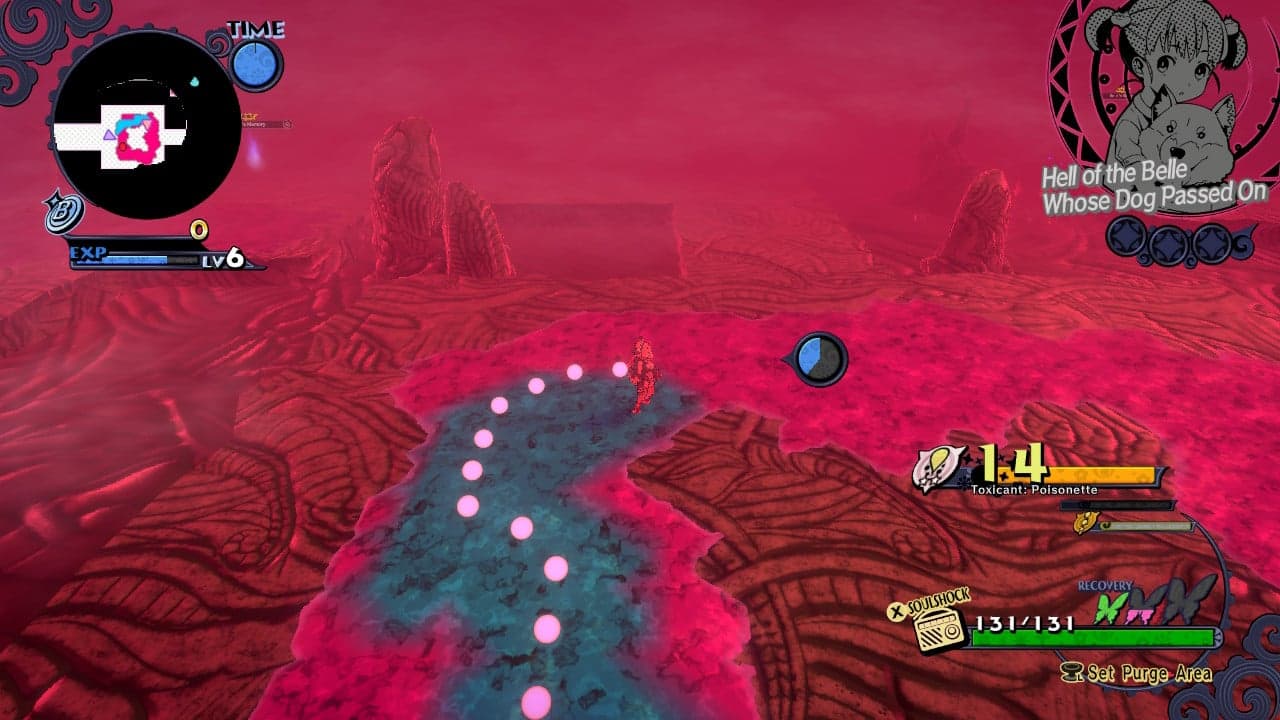
It was Oscar Wilde who said, ‘Imitation is the sincerest form of flattery that mediocrity can pay to greatness.’ This is Poison Control’s major malfunction – it’s just completely derivative of other games. And it does nothing much to hide that fact. From the Persona 5 palaces, hearts stealing, emotion changing, aesthetics and soundtrack, to the World Ends With You anime style, pop art, pins and stickers. It imitates almost every mechanic and story idea from other games, and instead of enhancing or building on these ideas and systems, or changing the formula, it doubles down, adding nothing new to the mix and coming off less than those it copies from.
It’s like a World End With You, but only on the surface level. And it’s like Persona 5 if you discount Persona’s rich and heartfelt and nuanced and massive story, and instead make the story bitesize, shallow and sometimes problematic. Poison Control copies from the best, but doesn’t delve deeply into any of the mechanics. Some of the elements are good; the music, the designs, the general script. But the actual gameplay, third-person shooting and the poison clearing are verging on dull. As a mix of genres neither play all that well, nor do they compliment each other.
Everything is surface level. The RPG mechanics have the depth of a puddle, the shooting has not been honed or polished, the miasma clearing game lacks direction, incentive and most egregiously, fun.
On the surface Poison Control looks to be cut from the same cloth as Persona, brimming with cute characters, witty script and changing hearts. But under the poison mires you need to clear and the poor shooting, the gameplay lacks polish and chokes on repetition, and the story often descends into caricature and mishandles a sexual assault. Its style is really only skin deep.

Poison Control is available now on the Nintendo Switch (review platform) and on PS4.
Developer: NIS America
Publisher: NIS America
Disclaimer: In order to complete this review, we purchased a copy of the game. For our full review policy, please go here.
If you enjoyed this article or any more of our content, please consider our Patreon.
Make sure to follow Finger Guns on our social channels – Twitter, Facebook, Twitch, Spotify or Apple Podcasts – to keep up to date on our news, reviews and features.
